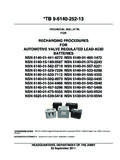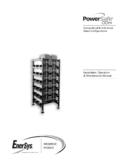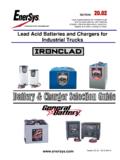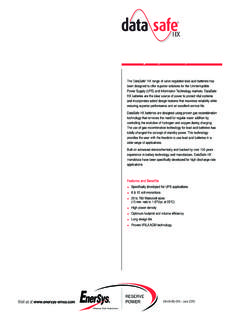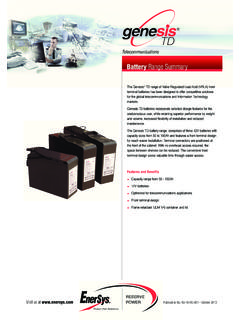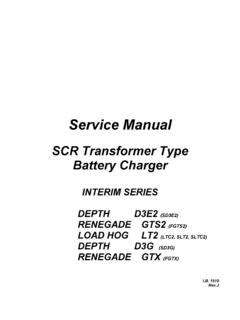Transcription of SAFETY DATA SHEET - Hawker Battery | EnerSys - …
1 Form #: SDS 853026 Revised: 05/14/15 Supersedes: NEWECO #: 1001584I. PRODUCT IDENTIFICATIONC hemical Trade Name (as used on label):Chemical Family/Classification:Aerospace and defense batteries manufactured using factory modified versions ofSealed Lead BatteryCyclon , Genesis , SBS, Hawker , Armasafe Plus , or Large :Sealed Lead Acid Battery , VRLA BatteryTelephone:For information and emergencies, contact EnerSys Energy ProductsManufacturer's Name/Address:Environmental, Health & SAFETY Dept. at 660-429-2165 EnerSys Energy Products Inc.
2 (formerly Hawker Energy Products Inc.)617 N. Ridgeview Drive24-Hour Emergency Response Contact:Warrensburg, MO 64093-9301 CHEMTREC DOMESTIC: 800-424-9300 CHEMTREC INT'L: 703-527-3877II GHS HAZRDS IDENTFICATIONA cute Toxicity(Oral/Dermal/Inhalation)Category 4 Skin Corrosion/IrritationCategory 1 AEye DamageCategory 1 ReproductiveCategory 1 ACarcinogenicity (lead compounds) Category 1 BCarcinogenicity (acid mist)Category 1 ASpecific Target Organ Toxicity(repeated exposure)Category 2 GHS LABEL.
3 Hazard StatementsPrecautionary StatementsDANGER!Wash thoroughly after severe skin burns and eye not eat, drink or smoke when using this serious eye protective gloves/protective clothing, eye protection/face damage fertility or the unborn child if ingested or Avoid breathing dust/fume/gas/mist/ only outdoors or in a well-ventilated cause cancer if ingested or skin irritation, serious eye damage to central nervous system, blood andContact with internal components may cause irritation or severe burns.
4 Avoid contact with internal through prolonged or repeated to eyes, respiratory system, and form explosive air/gas mixture during flammable gas (hydrogen).Explosive, fire, blast, or projection HAZARDOUS INGREDIENTS/IDENTIFY INFORMATIONCAS NumberApproximate % by WeightInorganic Lead Compound:Lead7439-92-145 - 60 Lead Dioxide1309-60-015 - - Acid Electrolyte (Sulfuric Acid/Water)7664-93-915 - 20 Case Material:5 - 10 Polypropylene9003-07-0 Polystyrene9003-53-6 Styrene Acrylonitrile9003-54-7 Acrylonitrile Butadiene Styrene9003-56-9 Styrene Butadiene9003-55-8 Polyvinylchloride9002-86-2 Polycarbonate, Hard Rubber, Polyethylene9002-88-4 Polyphenylene Oxide25134-01-4 Polycarbonate/Polyester Alloy--Other:Absorbent Glass Mat--1 - 2 Inorganic lead and sulfuric acid electrolyte are the primary components of every Battery manufactured by EnerSys Energy Products.
5 There are no mercury or cadmium containing products present in batteries manufactured by EnerSys Energy Chemical, Division SAFETY data SHEETHEALTHENVIRONMENTALPHYSICALA quatic Chronic 1 Aquatic Acute 1 HEALTHENVIRONMENTALPHYSICALC omponentsPage 1 Form #: SDS 853026 Revised: 05/14/15 Supersedes: NEWECO #: 1001584 SAFETY data SHEETIV. FIRST AID MEASURESI nhalation:Sulfuric Acid: Remove to fresh air immediately. If breathing is difficult, give oxygen. Consult a physicianLead: Remove from exposure, gargle, wash nose and lips; consult :Sulfuric Acid: Give large quantities of water; do not induce vomiting or aspiration into the lungs may occur and can cause permanent injury or death;consult a : Consult physician :Sulfuric Acid: Flush with large amounts of water for at least 15 minutes; remove contaminated clothing completely, including symptoms persist, seek medical attention.
6 Wash contaminated clothing before reuse. Discard contaminated : Wash immediately with soap and :Sulfuric Acid and Lead: Flush immediately with large amounts of water for at least 15 minutes while lifting immediate medical attention if eyes have been exposed directly to FIRE FIGHTING MEASURESF lash Point: N/AFlammable Limits: LEL = (Hydrogen Gas)UEL = (Hydrogen Gas)Extinguishing Media: Carbon dioxide; foam; dry chemical. Avoid breathing vapors. Use appropriate media for surrounding Fire Fighting Procedures: If batteries are on charge, shut off power.
7 Use positive pressure, self-contained breathing apparatus. Water applied to electrolyte generatesheat and causes it to spatter. Wear acid-resistant clothing, gloves, face and eye that strings of series connected batteries may still pose risk of electric shock even when charging equipment is shut Fire and Explosion Hazards:Highly flammable hydrogen gas is generated during charging and operation of batteries. To avoid risk of fire or explosion, keep sparks or othersources of ignition away from batteries.
8 Do not allow metallic materials to simultaneously contact negative and positive terminals of cells andbatteries. Follow manufacturer's instructions for installation and PRECAUTIONS FOR SAFE HANDLING AND USES pill or Leak Procedures:Stop flow of material, contain/absorb small spills with dry sand, earth, and vermiculite. Do not use combustible materials. If possible, carefullyneutralize spilled electrolyte with soda ash, sodium bicarbonate, lime, etc. Wear acid-resistant clothing, boots, gloves, and face shield.
9 Do notallow discharge of unneutralized acid to sewer. Acid must be managed in accordance with local, state, and federal state environmental agency and/or federal HANDLING AND STORAGEH andling:Unless involved in recycling operations, do not breach the casing or empty the contents of the Battery . There may be increasing risk of electric shock from strings of connected containers tightly closed when not in use. If Battery case is broken, avoid contact with internal vent caps on and cover terminals to prevent short circuits.
10 Place cardboard between layers of stacked automotive batteries to avoid damage and short away from combustible materials, organic chemicals, reducing substances, metals, strong oxidizers and water. Use banding or stretch wrap to secure items :Store batteries in cool, dry, well-ventilated areas with impervious surfaces and adequate containment in the event of spills. Batteries should also be stored under roof for protection against adverse weather conditions. Separate from incompatible materials. Store and handle only in areas with adequate water supply and spill control.

